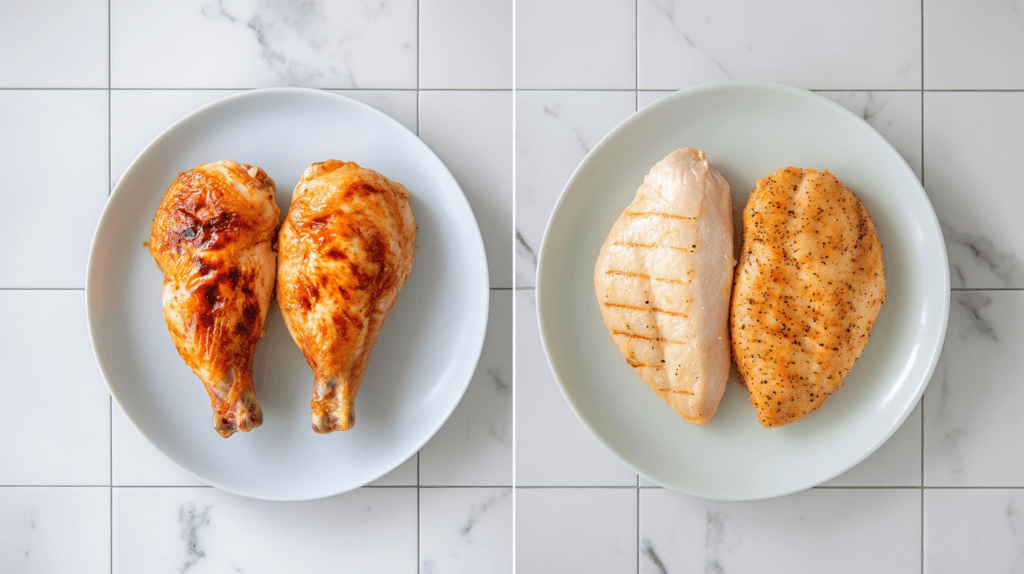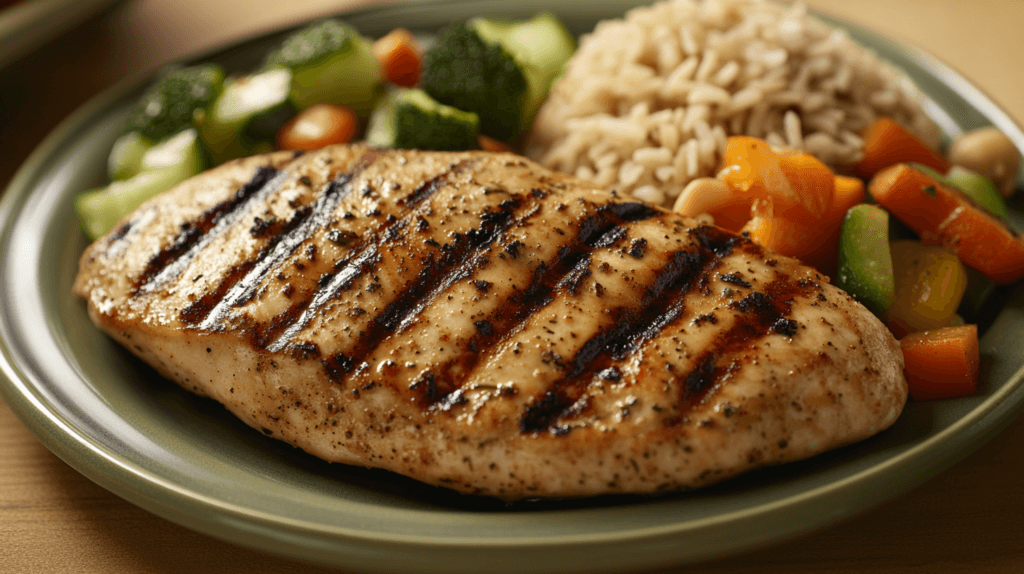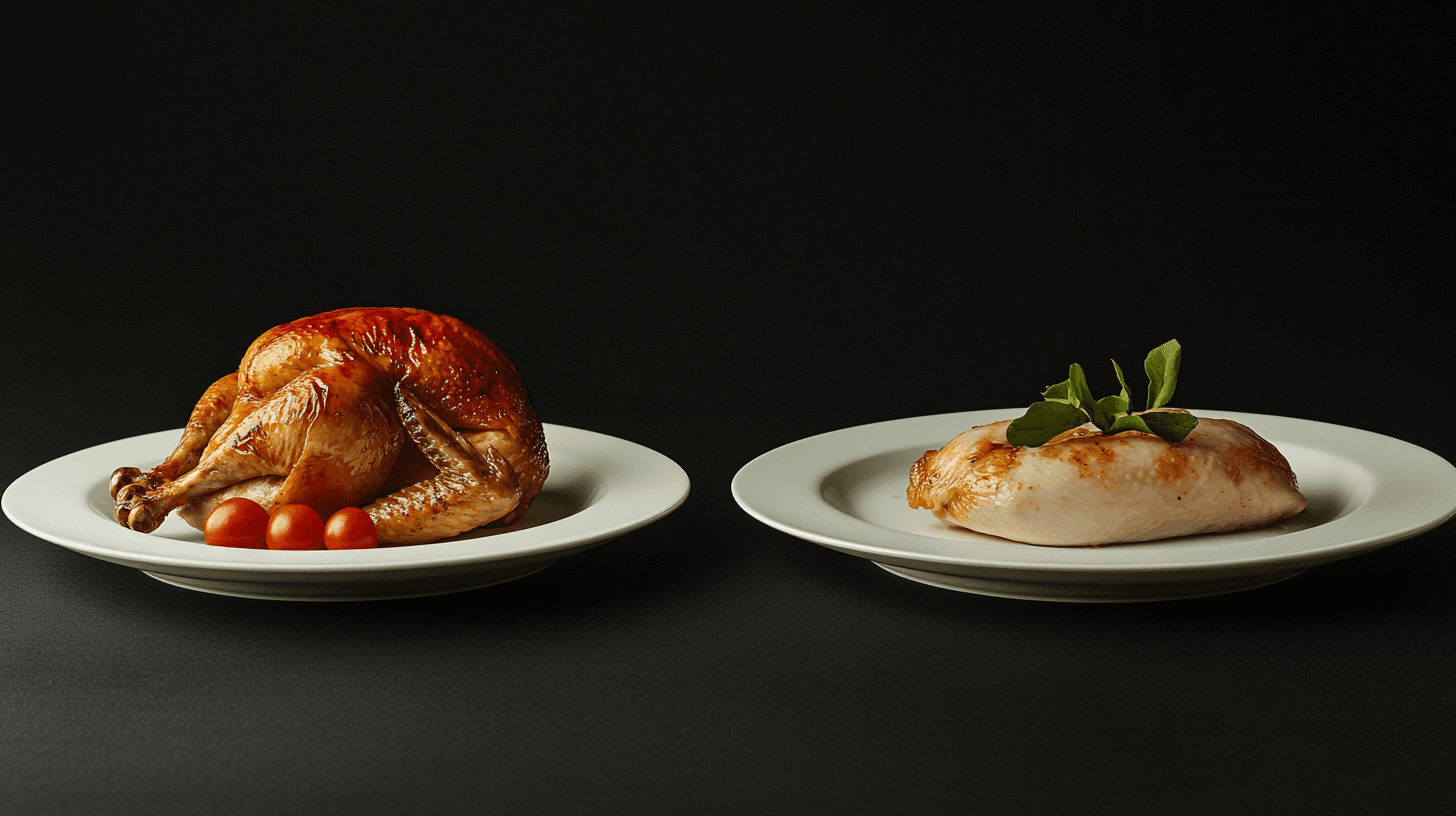Introduction
Importance of Understanding Nutritional Differences
In an era where maintaining a healthy lifestyle has become a priority, the importance of understanding the nutritional value of the food we consume cannot be overstated. Nutrition plays a pivotal role in shaping our overall well-being, influencing everything from energy levels to long-term health outcomes. However, navigating the diverse range of food options available today can be challenging without adequate knowledge. Making informed choices often requires a comparison of similar food items to identify the one that aligns best with our health and dietary goals.
A common comparison is between rotisserie chicken and plain chicken breast, both popular protein-rich choices found in meals, salads, and menus. While both provide high-quality protein, their preparation, calorie content, fat levels, and seasoning vary greatly in their nutritional impact.
Overview of Rotisserie Chicken and Chicken Breast
Rotisserie chicken is a convenient and flavorful option, often purchased pre-cooked from grocery stores or delis. It is seasoned with spices and cooked on a rotating spit, which gives it a tender, juicy texture and crispy skin. While undeniably delicious, rotisserie chicken may contain added fats, sodium, and preservatives depending on how it is prepared.
Plain chicken breast is a lean protein choice, typically cooked with minimal seasoning using methods like grilling, boiling, or baking. Its versatility and low fat and calorie content make it a staple for health-conscious individuals, especially when prepared without skin or added ingredients.
Understanding the nutritional differences helps individuals tailor meals to health goals like weight management, muscle building, or reducing sodium.
Nutritional Profiles
Caloric Comparison

The calorie content of rotisserie chicken and plain chicken breast can differ significantly due to their preparation methods. Rotisserie chicken, particularly when consumed with the skin, tends to have a higher calorie count. The added oils, seasonings, and the natural fat in the skin contribute to this increase. A 3-ounce serving of rotisserie chicken with skin can contain approximately 170-200 calories.
On the other hand, plain, skinless chicken breast is a much leaner option. A 3-ounce serving of skinless chicken breast typically contains around 100-120 calories, making it a preferred choice for individuals focused on calorie control or weight management.
Protein Content Differences
Both rotisserie chicken and chicken breast are excellent sources of high-quality protein, essential for muscle repair, immune function, and overall health. A 3-ounce serving of rotisserie chicken provides about 20-23 grams of protein, while the same serving size of chicken breast delivers 25-27 grams of protein.
The slight difference in protein content can be attributed to the addition of fats and seasonings in rotisserie chicken, which may reduce the proportion of protein in each bite. Chicken breast, being unseasoned and minimally processed, offers a purer source of protein.
Fat Content and Its Implications
The fat content is where the two options show a stark contrast. Rotisserie chicken, especially when eaten with the skin, contains more fat—ranging from 7 to 11 grams per 3-ounce serving. A considerable portion of this is saturated fat, which, if consumed in excess, can contribute to cardiovascular health risks.
In comparison, skinless chicken breast is exceptionally low in fat, with only 2-3 grams per 3-ounce serving. This makes it an ideal choice for those looking to reduce overall fat intake, particularly saturated fats, to maintain heart health and support a balanced diet.
Sodium Levels in Rotisserie Chicken vs. Chicken Breast
One of the most notable differences between rotisserie chicken and chicken breast is their sodium content. Rotisserie chicken is often seasoned and marinated with salt or sodium-based preservatives, resulting in a much higher sodium level. A 3-ounce serving can contain 250-450 milligrams of sodium, depending on the preparation. High sodium intake is linked to elevated blood pressure and increased risk of cardiovascular diseases.
In contrast, plain chicken breast, prepared without added salt, has a negligible sodium content—typically less than 100 milligrams per serving. This makes chicken breast a more suitable option for individuals managing their sodium intake, such as those with hypertension or other cardiovascular concerns.
Understanding these nutritional profiles enables individuals to make informed choices based on their dietary goals and health considerations, balancing taste, convenience, and nutrition effectively.
Health Benefits of Chicken Breast

Lean Protein and Muscle Building
Chicken breast is widely regarded as one of the best sources of lean protein, an essential macronutrient for building and repairing muscles. It contains all nine essential amino acids, making it a complete protein that supports muscle growth and recovery after exercise. For athletes, bodybuilders, or anyone pursuing a fitness regimen, chicken breast serves as an ideal dietary component to fuel muscle development and maintain overall strength.
The low-fat content of chicken breast ensures that individuals can increase their protein intake without consuming excessive calories or unhealthy fats, supporting lean muscle mass while promoting a toned physique.
Low Calorie and Weight Management
For those focused on weight management or loss, chicken breast offers a high-protein, low-calorie option. Its high protein content helps promote satiety, reducing overall hunger and preventing overeating. Consuming protein-rich foods like chicken breast has been shown to enhance metabolism due to the thermic effect of food, where more energy is used to digest protein compared to carbohydrates or fats.
A 3-ounce serving of skinless chicken breast provides around 100-120 calories, making it a versatile choice for low-calorie meal plans. Incorporating chicken breast into a balanced diet can help individuals manage their caloric intake without compromising nutritional quality.
Rich in Vitamins and Minerals
Chicken breast is not only a rich source of protein but also provides a variety of essential vitamins and minerals that contribute to overall health. It is an excellent source of:
- B Vitamins (B3, B6, and B12): These vitamins support energy production, brain function, and red blood cell formation.
- Phosphorus: Important for maintaining healthy bones and teeth as well as supporting kidney function.
- Selenium: An antioxidant mineral that plays a critical role in immune function and protecting cells from oxidative stress.
These nutrients make chicken breast a nutrient-dense food that supports health, balances energy, boosts immunity, and promotes proper body functions.
Including chicken breast in the diet provides lean protein, essential nutrients, and weight management benefits, making it a key part of healthy eating.
Health Benefits of Rotisserie Chicken
Convenience and Availability
One of the primary advantages of rotisserie chicken is its convenience. Pre-cooked and ready to eat, it offers a time-saving solution for busy individuals or families. Available at most grocery stores, rotisserie chicken is an accessible option for a quick and nutritious meal. For creative meal ideas using leftover rotisserie chicken, check out these delicious recipes. It eliminates the need for extensive preparation or cooking skills, making it a practical choice for those with hectic schedules or limited kitchen resources.
Additionally, the versatility of rotisserie chicken allows it to be easily incorporated into various dishes, from salads and wraps to soups and casseroles, enhancing its appeal as a ready-to-use protein source.
Retains Moisture and Flavor
Rotisserie chicken is cooked slowly on a rotating spit, a method that helps retain moisture and enhances flavor. The slow-cooking process ensures that the meat remains tender and juicy while the outer skin becomes crisp and golden. This makes rotisserie chicken a flavorful alternative to other pre-cooked or processed protein options.
The rich taste and texture often eliminate the need for additional sauces or heavy dressings, which can reduce the overall calorie content of a meal. Its naturally savory profile makes it a satisfying option for individuals looking to enjoy their food without compromising on nutrition.
Source of Essential Nutrients
Despite its higher fat and sodium content compared to plain chicken breast, rotisserie chicken still provides a wealth of essential nutrients. A typical serving offers:
- High-Quality Protein: Essential for muscle repair, immune function, and overall body maintenance.
- B Vitamins: Includes B3 (niacin), B6, and B12, which support energy metabolism, brain health, and the production of red blood cells.
- Minerals: Contains phosphorus, selenium, and zinc, which are crucial for bone health, immune support, and cellular repair.
When consumed in moderation and paired with nutrient-dense side dishes like vegetables or whole grains, rotisserie chicken can be part of a balanced and healthy diet.
While not as lean as chicken breast, rotisserie chicken offers convenience, flavor, and nutrition, making it a practical choice for balanced diets.
Cooking Methods and Their Impact

Rotisserie Cooking Process
Rotisserie cooking involves roasting meat on a rotating spit, which allows for even heat distribution. This method helps lock in moisture, resulting in tender and juicy meat with a crispy exterior. The slow and steady rotation ensures the chicken is cooked thoroughly, minimizing the risk of undercooking.
However, the seasoning and basting often used in rotisserie cooking can increase the fat and sodium content. Butter, oil, or marinades may be applied to enhance flavor and moisture, contributing to higher calorie and sodium levels compared to other cooking methods. Despite this, rotisserie cooking preserves the natural flavors and makes the chicken versatile for various dishes.
If you’re planning to reheat rotisserie chicken, follow this guide to preserve its flavor and texture.
Comparison with Grilled and Boiled Chicken
Grilled chicken, like rotisserie chicken, retains a smoky, flavorful profile but typically has less fat because it is not basted or cooked with skin. Grilling allows excess fat to drip off during cooking, making it a leaner option. However, grilling at high temperatures can sometimes lead to the formation of harmful compounds like heterocyclic amines (HCAs), especially if the meat is charred.
Boiled chicken, on the other hand, is one of the leanest and simplest preparation methods. Boiling does not require added fats, and any excess fat from the meat often separates and can be removed. This method is ideal for those focusing on low-calorie or low-fat diets. However, boiling can sometimes result in a less flavorful product unless herbs or spices are added to the cooking water.
Retention of Nutrients in Different Cooking Methods
Cooking methods can significantly affect the nutrient retention of chicken:
- Rotisserie Cooking: Retains most of the chicken’s natural protein, vitamins, and minerals. However, the addition of oils, salts, or other ingredients can alter its nutritional profile.
- Grilling: Preserves nutrients effectively while reducing fat content due to its draining effect. Careful grilling minimizes nutrient loss, but overcooking can degrade some vitamins, such as B6.
- Boiling: Maintains the integrity of most nutrients, especially if the cooking water is consumed (e.g., in soups or broths). However, some water-soluble vitamins, such as B vitamins, may leach into the water during cooking.
Understanding cooking methods helps individuals align choices with nutritional goals and taste preferences. Rotisserie cooking offers flavor and convenience, while grilling and boiling provide healthier, leaner options with better nutrient retention.
Expert Opinions and Studies
Nutritionists’ Views on Rotisserie Chicken
Nutritionists generally agree that rotisserie chicken can be a convenient and nutritious option when consumed in moderation. Its high protein content makes it a valuable source of essential amino acids for muscle repair and overall body function. However, many experts caution against regular consumption of rotisserie chicken due to its higher fat and sodium levels compared to plain, skinless chicken breast.
Some nutritionists highlight that the skin, where much of the fat resides, can be removed to reduce calorie and fat intake. Additionally, choosing rotisserie chicken varieties with minimal seasoning or additives is recommended to avoid excessive sodium and preservatives. Experts also suggest pairing rotisserie chicken with nutrient-rich sides, such as steamed vegetables or whole grains, to create a balanced meal.
Scientific Studies Comparing Health Impacts
Scientific research comparing the health impacts of rotisserie chicken and other cooking methods provides valuable insights:
- Fat and Sodium Content: Studies show rotisserie chicken has more fat and sodium than boiled or grilled chicken. The skin and preparation process contribute to this. High sodium is linked to hypertension, and excess saturated fat may raise heart disease risks.
- Nutritional Preservation: Research shows rotisserie cooking retains protein, vitamins, and minerals thanks to moderate temperatures and even heating. However, some studies suggest that grilling may better preserve lean protein content while boiling minimizes fat content.
- Convenience vs. Health Trade-offs: A 2020 study found that relying on pre-cooked options like rotisserie chicken boosts protein intake but increases sodium and fat consumption. The study recommended moderation and informed choices, such as opting for skinless portions.
Overall, nutritionists and studies recognize rotisserie chicken’s convenience and nutrition but stress mindful consumption with nutrient-rich sides. These insights can guide individuals in making informed dietary decisions based on their health goals.
FAQs About Rotisserie Chicken and Chicken Breast
Is rotisserie chicken healthier than chicken breast?
Rotisserie chicken is not necessarily healthier than chicken breast. While it offers convenience and flavor, rotisserie chicken often contains added fats and higher sodium levels due to the seasoning and cooking process. Chicken breast, particularly when prepared skinless and without added fats, is a leaner option with fewer calories and less sodium. It is better suited for individuals prioritizing weight management or reducing their sodium intake.
Can I eat rotisserie chicken on a weight-loss diet?
Yes, you can eat rotisserie chicken on a weight-loss diet, but moderation is key. To reduce calorie and fat intake, remove the skin and focus on the lean meat portions. Pair rotisserie chicken with low-calorie, nutrient-dense sides like vegetables or salads. Avoid consuming heavily seasoned or overly salted varieties, as they may contribute to higher sodium levels, which can impact water retention and overall health.
What are the nutritional differences between rotisserie chicken and chicken breast?
- Calories: Rotisserie chicken generally has more calories due to the skin and added fats, while chicken breast is lower in calories.
- Protein: Both are excellent protein sources, but chicken breast typically contains slightly more protein per serving.
- Fat: Rotisserie chicken, especially with the skin, has higher fat content, including saturated fats, compared to lean chicken breast.
- Sodium: Rotisserie chicken has significantly more sodium because of the seasoning and preparation methods, whereas plain chicken breast is much lower in sodium.
Is rotisserie chicken safe to eat every day?
While rotisserie chicken is safe to eat, consuming it every day is not ideal due to its higher sodium and fat content, which can have long-term health implications, such as increased blood pressure or cardiovascular risks. For daily consumption, consider alternating with other lean protein sources like chicken breast, fish, or plant-based proteins. If you opt for rotisserie chicken frequently, choose minimally seasoned options, remove the skin, and pair it with a balanced variety of nutrient-dense foods.
For tips on how to store rotisserie chicken properly, read this article.
By understanding these nuances, you can make more informed choices about including rotisserie chicken and chicken breast in your diet.
Conclusion
Final Verdict: Is Rotisserie Chicken Just as Healthy as Chicken Breast?
Both rotisserie chicken and chicken breast have benefits, but chicken breast is healthier for lean protein and low sodium. Rotisserie chicken offers convenience and flavor but often includes added fats and sodium that may not suit all dietary goals.
Rotisserie chicken can still be nutritious when eaten mindfully, especially without the skin and with healthy sides. Its protein, B vitamins, and minerals make it suitable for occasional use or quick meals. However, for individuals seeking stricter dietary control, particularly for weight management or cardiovascular health, chicken breast remains the superior option.
Key Takeaways for Informed Dietary Choices
- Assess Your Goals: Choose chicken breast if you aim to reduce calorie, fat, or sodium intake. Opt for rotisserie chicken when convenience and flavor are priorities, but consume it in moderation.
- Be Mindful of Preparation: Removing the skin from rotisserie chicken lowers its fat and calorie content. This makes it closer to chicken breast nutritionally.
- Balance Your Plate: Pair rotisserie chicken or chicken breast with vegetables, whole grains, or healthy fats. This creates a balanced meal.
- Consider Variety: Include both options in your diet, along with other protein sources like fish, legumes, and tofu, to ensure nutritional diversity.
Ultimately, informed choices based on your health goals, lifestyle, and taste preferences will help you strike the right balance between nutrition, convenience, and enjoyment.

